Aesthetic Grounds: June 2008 Archives
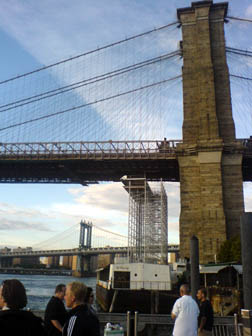
MOMA and PS1 prepare the public for the "Watersfalls" later this month in NYC. The the scaffolding has been constructed under the Brooklyn bridge. Photo taken on May 26.
From the Bay Area and Boston emerge artworks that are mainly science projects overlaid with pretty colors so they can be called "art". The interaction is fun for ten minutes and we like to take new visitors as they will marvel. We fake enthusiasm based on a memory our our first time so that we can truly enjoy their reaction. But the work fails to provide any personal thrill again. And for all the statements by the artists and curators, no significant thought comes to mind at all - except the terror of the possible future.
Olafur Eliasson moves between public science project and public art. Many are science tricks directed toward internal artworld reflections. A moving colorfield painting in light, the live black&white 3-D movie or the invisible white gallery box inside the white gallery box. Some are little silly like the reverse cascading waterfall where he sprays the water up from one pool to the next.
The genius of Eliasson emits from his stubborn battle with the photographic record: still or moving. He seeks to make works that can only be completely appreciated through "being-in" the artwork. (I have written about "being-in" regarding the architecture in the northwest USA - a place grounded in Scandinavian culture like Eliasson). Yet, many of Eliasson's best installations "The Weather Project" at the Tate Modern in London and the 360 Degree Room of All Colours at MOMA generate "artistic" amateur photos in the same way as Gromley's work. His is a battle, not a rejection.
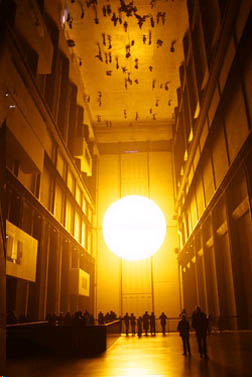
Anything claiming to be art requires the in-person experience to be fully appreciated. If you see a documentary picture or video of an artwork and think the artwork will be the same in person, then in my book you have a problem. (Of course the LCD monitor or paper magazine can be the intended home of the art.) The amateur photographs of The Weather Project make me want to be there. Through the photos, I have a sense, true or not, that the experience would be romantic and enveloping. Gromley's work makes me want to compete in the undeclared photo taking contest, not necessarily to be in the space. Eliasson's photos make me dream of the visit.
Two of the works at MOMA are brilliant and the "Take Your Time" room at PS1 exceeds any carnival fun-house of mirror rooms and tricks. Completely ignored by nearly all visitors, beige moss - of a type used for architectural models - densely covers each inch of the large gallery wall. Moss Wall is a visual trip over the Amazon Rain forest. Only by viewing the work from 6-10 inches can it unfold. As that visual range, the human eye and brain together imagine "depth of field" and a complete 3D visual experience that become physical. The human brain feels the tiny changes in elevation as you move your head and eyes like an airplane plane. But at 200 or 300 feet above a real forest, the eyes and brain do not feel any 3D effect. Eliasson discovered that multidimensional physical reactions can be sparked in the body.
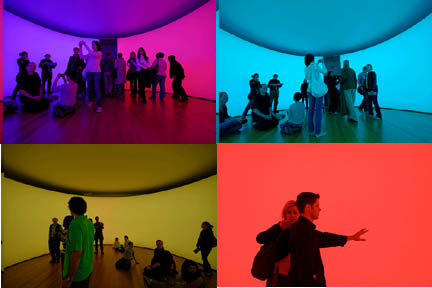
360 Degree Room of All Colours turns color into music. The circular space changes its pastel colors in slow repetition. The light level is PERFECT for the human eye in that pupil is fully open without the need to squint. If you stare into the fabric walls from 10 inches, your entire field of vision fills with one color. Only on a sail-less boat in the sea with a low sun, can you stare at the dome of the sky with a similar full view of blue. I loved it, but this is not the surprising part. If you sit of floor and a stare, the color change from washed out to very intensive pastel. My body started to feel the motion of the colors in ways that can only be compared to music. The chemical levels in my body shot up with the swelling of the color intensity.
Since architecture school, I had been told of psychological power of color, but never the physiological. Still part science, but like other chemicals in the body, I am hooked and looking for my next dose.
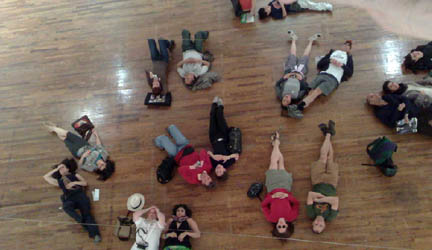
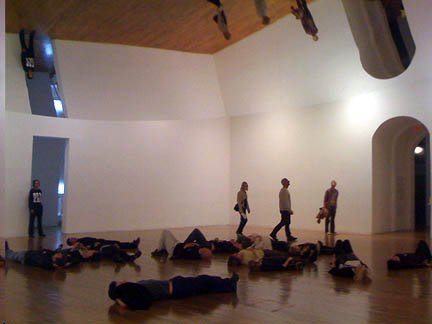
Finally, Take Your Time at PS1. A huge disc cover red in reflective mylar rotates very slow on the ceiling. Immediately, everyone dives to floor and looks up. Your brain tells you that all the people - including yourself - are not lying on the floor, but suspended magically on a vertical wall with less effort that Spiderman. That is the fun house trick. The questions is - why do you want to lay there for minutes and minutes? People don't want to leave.
The mirror is tilted about 3%. Patience and 3% is the genius of the work. The angle causes the reflection of the visitors and the walls of the room to change very, very slightly in a loop. Again, somehow and for some reason, the brain knows that the view is changing and therefore remains alerts and interested. Unless you move the very edge of the disk, you can get yourself to consciously recognise the change. Like the colors in the 360 Degree Room, you body responds - in this case the brain - without consciousness.
Perhaps Eliasson has invented the first of science of art since gestalt.
I don't know how other creative people can utilize Eliasson's operational observations, but the work drives home the memory of special sunsets and hours napping adjacent to a waterfall in the forest. He proves that humans can make the spaces that facilitate these calm and happy moments. Thank you Mr. Eliasson.
Thank you for the Images
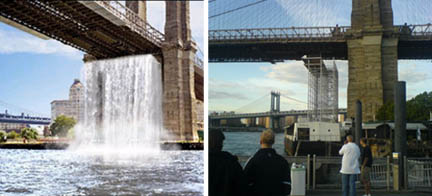
The Waterfalls produced by the Public Art Fund. Opening soon.
Blogroll
AJ Ads
AJ Blogs
AJBlogCentral | rssculture
Terry Teachout on the arts in New York City
Andrew Taylor on the business of arts & culture
rock culture approximately
Laura Collins-Hughes on arts, culture and coverage
Richard Kessler on arts education
Douglas McLennan's blog
Dalouge Smith advocates for the Arts
Art from the American Outback
For immediate release: the arts are marketable
No genre is the new genre
David Jays on theatre and dance
Paul Levy measures the Angles
Judith H. Dobrzynski on Culture
John Rockwell on the arts
Jan Herman - arts, media & culture with 'tude
dance
Apollinaire Scherr talks about dance
Tobi Tobias on dance et al...
jazz
Howard Mandel's freelance Urban Improvisation
Focus on New Orleans. Jazz and Other Sounds
Doug Ramsey on Jazz and other matters...
media
Jeff Weinstein's Cultural Mixology
Martha Bayles on Film...
classical music
Fresh ideas on building arts communities
Greg Sandow performs a book-in-progress
Exploring Orchestras w/ Henry Fogel
Harvey Sachs on music, and various digressions
Bruce Brubaker on all things Piano
Kyle Gann on music after the fact
Greg Sandow on the future of Classical Music
Norman Lebrecht on Shifting Sound Worlds
publishing
Jerome Weeks on Books
Scott McLemee on books, ideas & trash-culture ephemera
theatre
Wendy Rosenfield: covering drama, onstage and off
Chloe Veltman on how culture will save the world
visual
Public Art, Public Space
Regina Hackett takes her Art To Go
John Perreault's art diary
Lee Rosenbaum's Cultural Commentary
Tyler Green's modern & contemporary art blog
